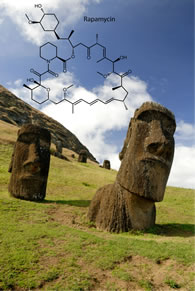News Release: Research
Jun. 22, 2009
Transplant Drug Stimulates Immune Memory
 The immunosuppressant drug rapamycin was discovered in soil from Easter Island. Download hi-res version of this image..
The immunosuppressant drug rapamycin was discovered in soil from Easter Island. Download hi-res version of this image..Rapamycin, a drug given to transplant recipients to suppress their immune systems, has a paradoxical effect on cells responsible for immune memory, scientists at the Emory Vaccine Center have discovered.
In experiments conducted in both mice and monkeys, rapamycin can stimulate the formation of memory CD8 T cells, which enable the immune system to respond faster and stronger to an infectious agent upon a second encounter.
The results were published online ahead of print June 21 in Nature. The finding means that doctors might be able to boost the effectiveness of vaccines with drugs that act similarly to rapamycin, says postdoctoral researcher Koichi Araki, PhD, who is first author.
Araki works in the laboratory of Rafi Ahmed, PhD, director of the Emory Vaccine Center and a Georgia Research Alliance Eminent Scholar.
Vaccination relies on memory T cells, survivors after the immune system produces an abundance of T cells to fight an infection or respond to a vaccine. Araki had been examining rapamycin's effects in mice infected with lymphocytic choriomeningitis virus (LCMV).
"Usually during the response to this virus, 90 percent of the CD8 T cells produced to fight an infection die after a few weeks. The memory cells are generated from the 10 percent that survive," he explains.
T cells come in both CD4 (helper) and CD8 (killer) forms, but scientists have found that CD8 T cells are more important for fighting LCMV.
When mice were treated with rapamycin, more CD8 T cells that react against LMCV survived, Araki found. Under the influence of rapamycin, the mice not only produced more memory T cells, but the cells had a greater ability to proliferate and respond upon a second exposure to LCMV.
Rapamycin's effects are "surprising and unexpected," Araki says. During a transient viral infection, the targets of the immune response eventually disappear, a situation markedly different from a transplant, Araki notes. That difference may have helped him recognize rapamycin's effects, he says.
Also, rapamycin's effects depend on the dose -- too high a dose will inhibit all T cells without regard to what type they are, he says.
Araki and Ahmed teamed up with Christian Larsen, MD, PhD, director of the Emory Transplant Center and chair of the Department of Surgery, to show that rapamycin had similar effects in rhesus macaques infected with vaccinia virus as in mice. That research was conducted at Emory's Yerkes National Primate Research Center.
Rapamycin, also called sirolimus, was approved by the FDA in 1999 for use after kidney transplants. It was discovered in a soil sample from Easter Island, whose Polynesian name is Rapa Nui.
Transplant patients usually don't take rapamycin by itself, so rapamycin's paradoxical effects may have been masked by other drugs, Larsen says.
For transplant patients, memory T cells can play a role in graft rejection, but they can also protect against infections.
"We are appreciating more and more that memory T cells respond differently to interventions than naïve T cells and we have to pay close attention to the situation of the individual patient," Larsen says.
Scientists at the Emory Vaccine Center continue to study how T cells decide whether to become memory cells, because of their importance in maintaining the immune response against chronic infections such as HIV and hepatitis C.
The effects of rapamycin were seen even if Araki gave animals rapamycin only for a week after the infection began, suggesting that the beginning of the infection was when T cells were deciding whether or not to become memory cells.
By using an inhibitory technique (RNA interference) on the genes known to be targeted by rapamycin, Araki was able to show that rapamycin is acting on the CD8 T cells and not on other cells with which they interact.
The research was supported by the National Institutes of Health.
Reference:
K. Araki, A.P. Turner, V.O. Shaffer, S. Gangappa, S. Keller, M.F. Bachmann, C.P. Larsen and R. Ahmed. mTOR regulates memory CD8 T cell differentiation. Nature (2009).
###
The Robert W. Woodruff Health Sciences Center of Emory University is an academic health science and service center focused on missions of teaching, research, health care and public service. Its components include schools of medicine, nursing, and public health; Yerkes National Primate Research Center; the Emory Winship Cancer Institute; and Emory Healthcare, the largest, most comprehensive health system in Georgia. The Woodruff Health Sciences Center has a $2.3 billion budget, 17,000 employees, 2,300 full-time and 1,900 affiliated faculty, 4,300 students and trainees, and a $4.9 billion economic impact on metro Atlanta.
Learn more about Emory’s health sciences:
Blog: http://emoryhealthblog.com
Twitter: @emoryhealthsci
Web: http://emoryhealthsciences.org
